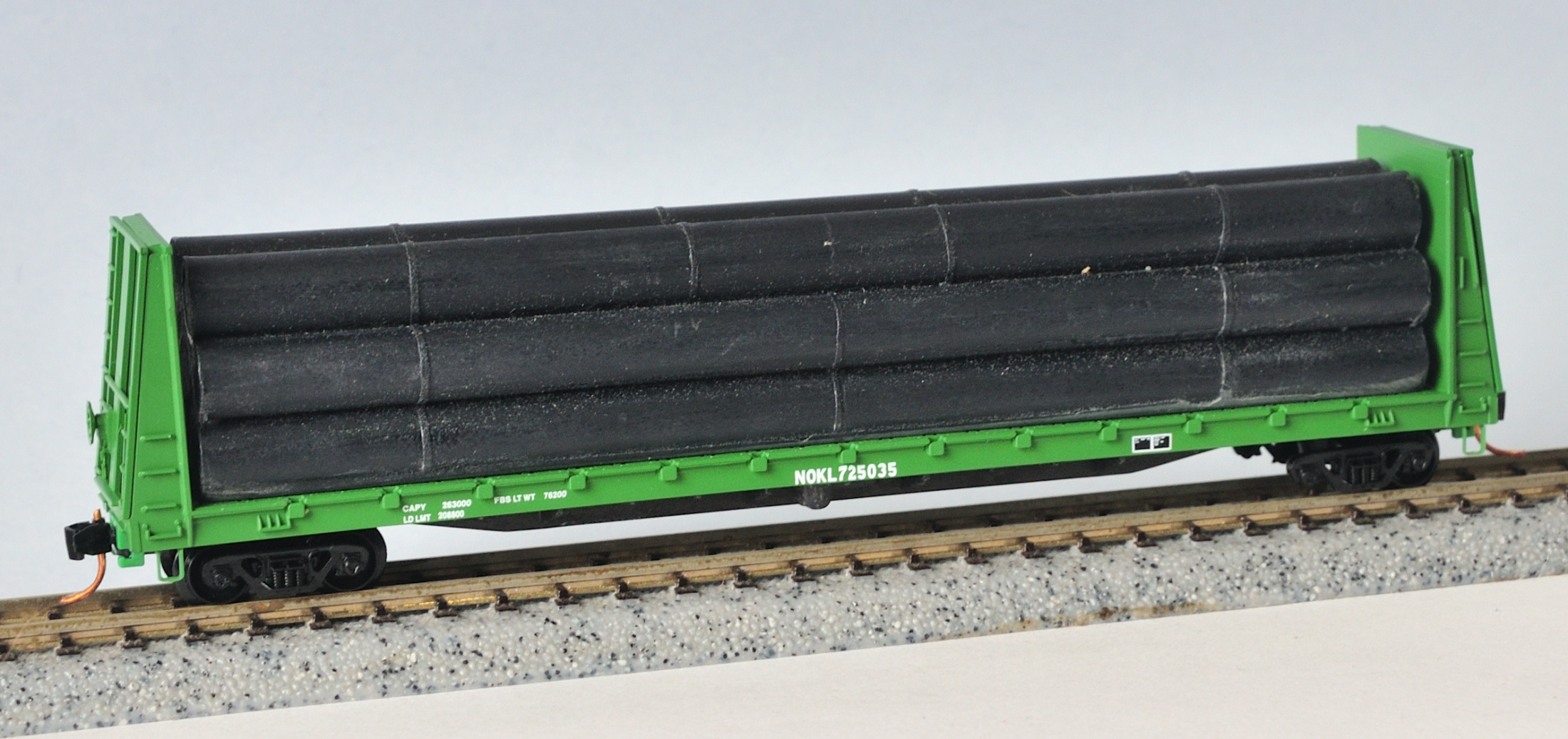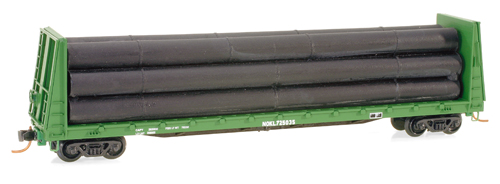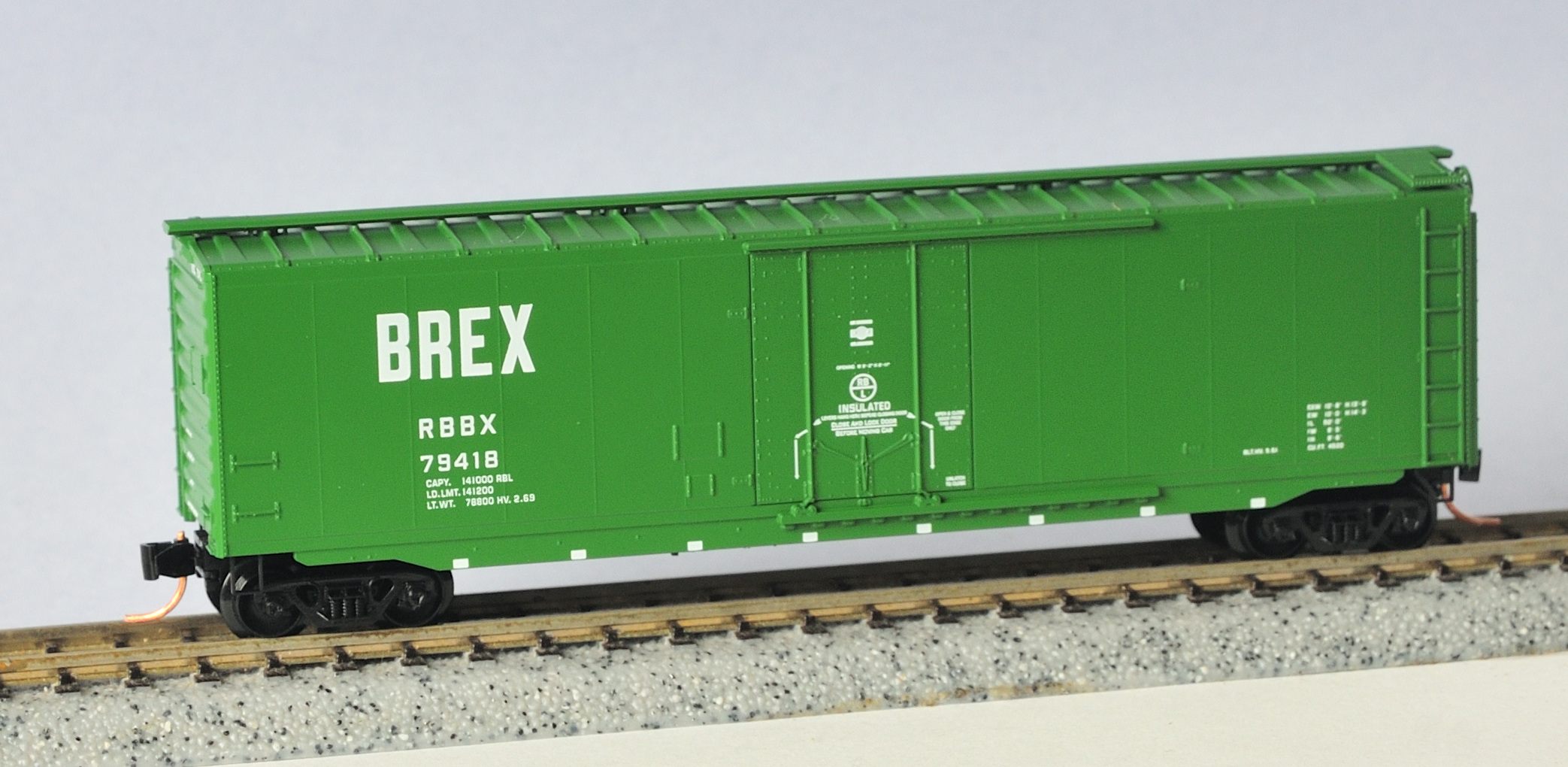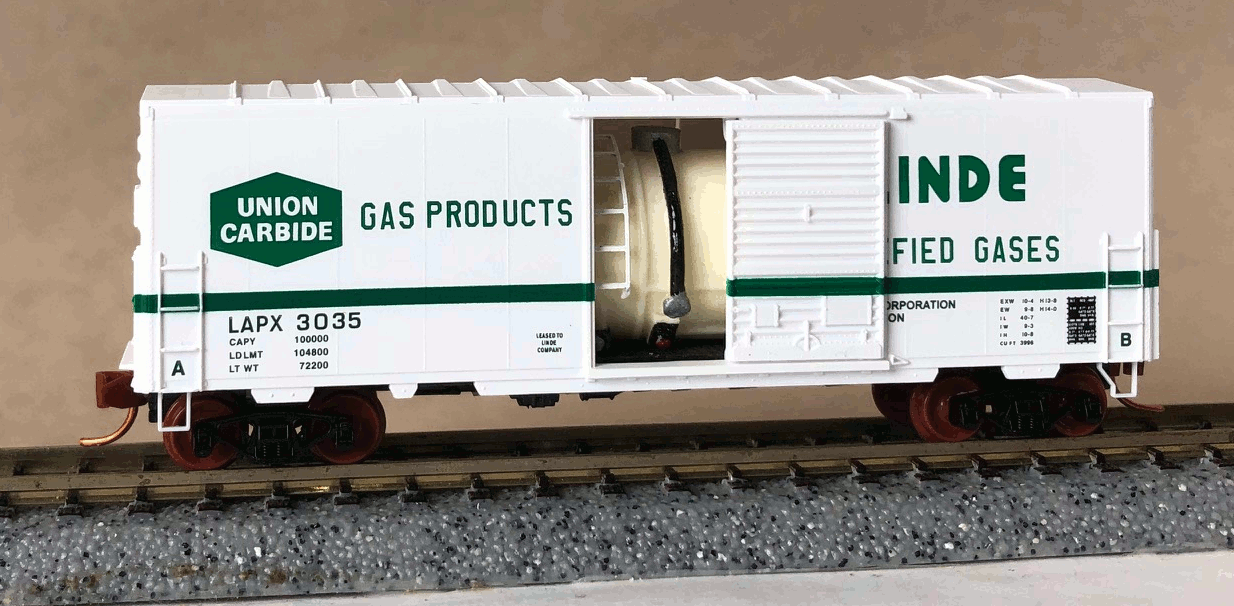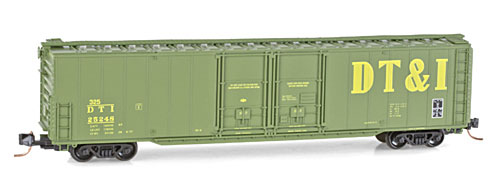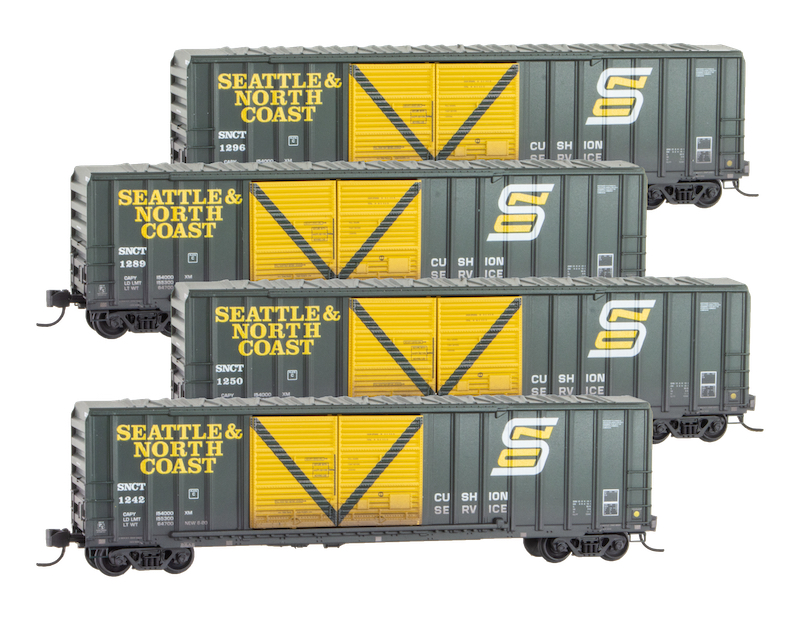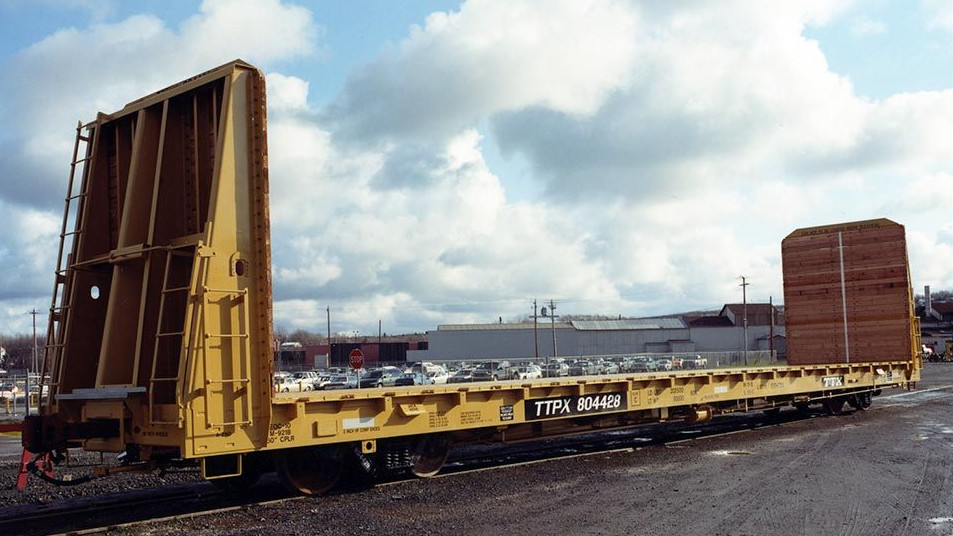Prototype History: Among the earliest types of freight cars, flatcars continue to serve as a valuable part of railroading. Flatcars are used to move a wide variety of loads which do not require protection from weather. These cars, are constructed with steel underframes, wood floors and stake pockets on the sides and ends for fastening tie-downs that keep loads from shifting.
Bulkhead flat cars are a specialized type of flatcar designed which includes reinforced end-walls (bulkheads) to prevent loads from shifting past the ends of the car.
Bulkhead flat cars are a specialized type of flatcar designed which includes reinforced end-walls (bulkheads) to prevent loads from shifting past the ends of the car.
Road Name History: 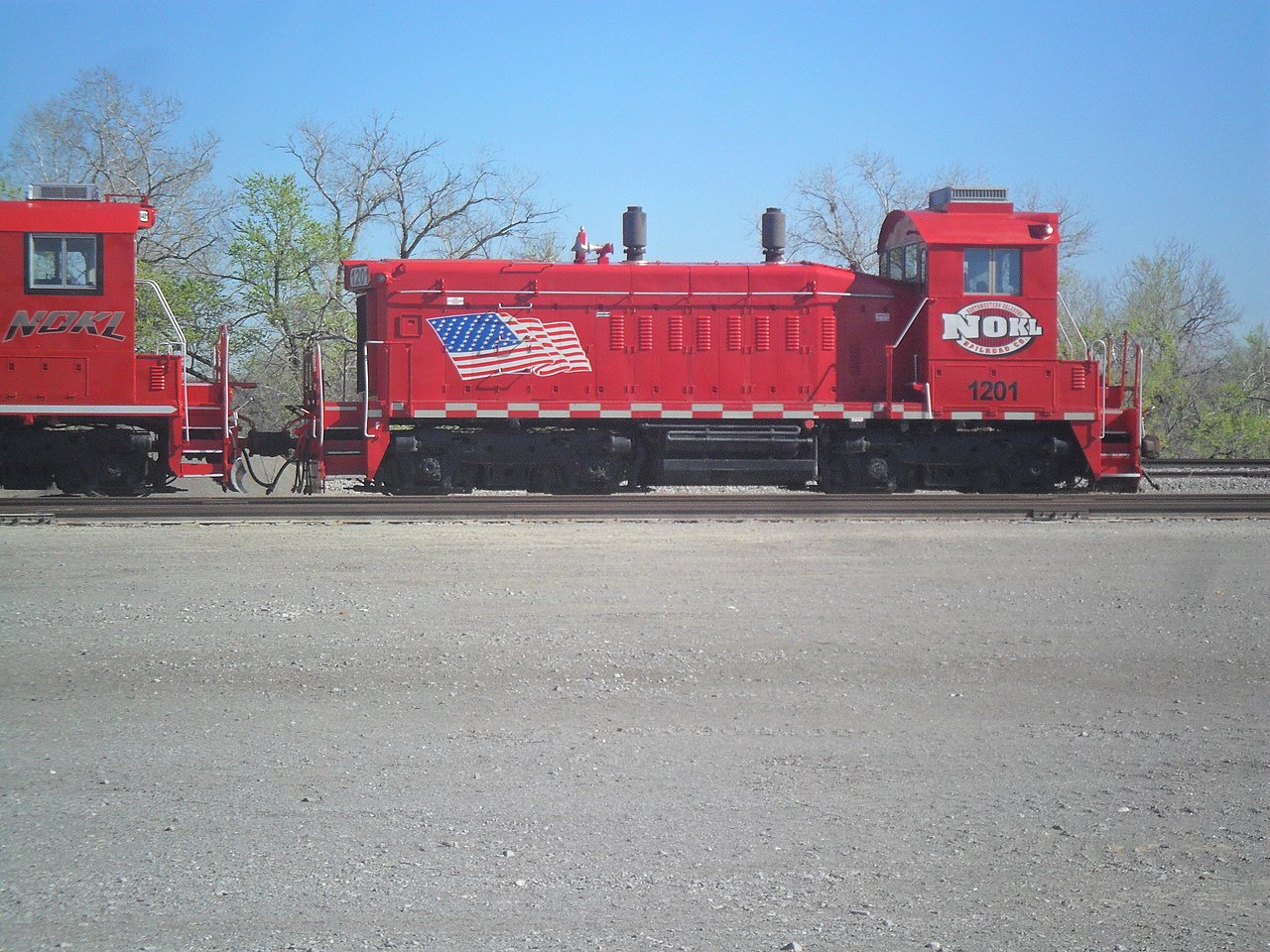 NOKL was established in 1973 to take over operation of the 9 mile former M-K-T line connecting Fisk, Woodward and Warner, Oklahoma. Customers include a grain elevator and a railroad car repair shop. They currently lease out their reporting marks so the many thousands of freight cars lettered NOKL actually belong to the First Union Rail car leasing operation and not this shortline.
NOKL was established in 1973 to take over operation of the 9 mile former M-K-T line connecting Fisk, Woodward and Warner, Oklahoma. Customers include a grain elevator and a railroad car repair shop. They currently lease out their reporting marks so the many thousands of freight cars lettered NOKL actually belong to the First Union Rail car leasing operation and not this shortline.
This begs the question, why a leasing company would bother to lease a shortline’s reporting marks when they could just use their own (something ending in X such as NDYX, also used by First Union.) There is a difference between private owners and railroad owners in how car-hire is billed. Private owner cars are billed by the mile. Railroad owned cars are billed by a complex formula including per diem, the age of the car and the mileage. Therefore, depending on the service, the leasing companies earn more by using a railroad reporting mark for a car and other times they are better off running the car as a private owner.

This begs the question, why a leasing company would bother to lease a shortline’s reporting marks when they could just use their own (something ending in X such as NDYX, also used by First Union.) There is a difference between private owners and railroad owners in how car-hire is billed. Private owner cars are billed by the mile. Railroad owned cars are billed by a complex formula including per diem, the age of the car and the mileage. Therefore, depending on the service, the leasing companies earn more by using a railroad reporting mark for a car and other times they are better off running the car as a private owner.
Brand/Importer Information: Micro-Trains is the brand name used by both Kadee Quality Products and Micro-Trains Line. For a history of the relationship between the brand and the two companies, please consult our Micro-Trains Collector's Guide.
Manufacturer Information:  Micro-Trains Line split off from Kadee Quality Products in 1990. Kadee Quality Products originally got involved in N-Scale by producing a scaled-down version of their successful HO Magne-Matic knuckle coupler system. This coupler was superior to the ubiquitous 'Rapido' style coupler due to two primary factors: superior realistic appearance and the ability to automatically uncouple when stopped over a magnet embedded in a section of track. The success of these couplers in N-Scale quickly translated to the production of trucks, wheels and in 1972 a release of ready-to-run box cars.
Micro-Trains Line split off from Kadee Quality Products in 1990. Kadee Quality Products originally got involved in N-Scale by producing a scaled-down version of their successful HO Magne-Matic knuckle coupler system. This coupler was superior to the ubiquitous 'Rapido' style coupler due to two primary factors: superior realistic appearance and the ability to automatically uncouple when stopped over a magnet embedded in a section of track. The success of these couplers in N-Scale quickly translated to the production of trucks, wheels and in 1972 a release of ready-to-run box cars.
Micro-Trains Line Co. split off from Kadee in 1990 to form a completely independent company. For this reason, products from this company can appear with labels from both enterprises. Due to the nature of production idiosyncrasies and various random factors, the rolling stock from Micro-Trains can have all sorts of interesting variations in both their packaging as well as the products themselves. When acquiring an MTL product it is very important to understand these important production variations that can greatly enhance (or decrease) the value of your purchase.
Please consult our Micro-Trains Collector's Guide

Micro-Trains Line Co. split off from Kadee in 1990 to form a completely independent company. For this reason, products from this company can appear with labels from both enterprises. Due to the nature of production idiosyncrasies and various random factors, the rolling stock from Micro-Trains can have all sorts of interesting variations in both their packaging as well as the products themselves. When acquiring an MTL product it is very important to understand these important production variations that can greatly enhance (or decrease) the value of your purchase.
Please consult our Micro-Trains Collector's Guide
Item created by: Lethe on 2015-05-31 17:46:30. Last edited by George on 2024-01-26 20:28:48
If you see errors or missing data in this entry, please feel free to log in and edit it. Anyone with a Gmail account can log in instantly.
If you see errors or missing data in this entry, please feel free to log in and edit it. Anyone with a Gmail account can log in instantly.


